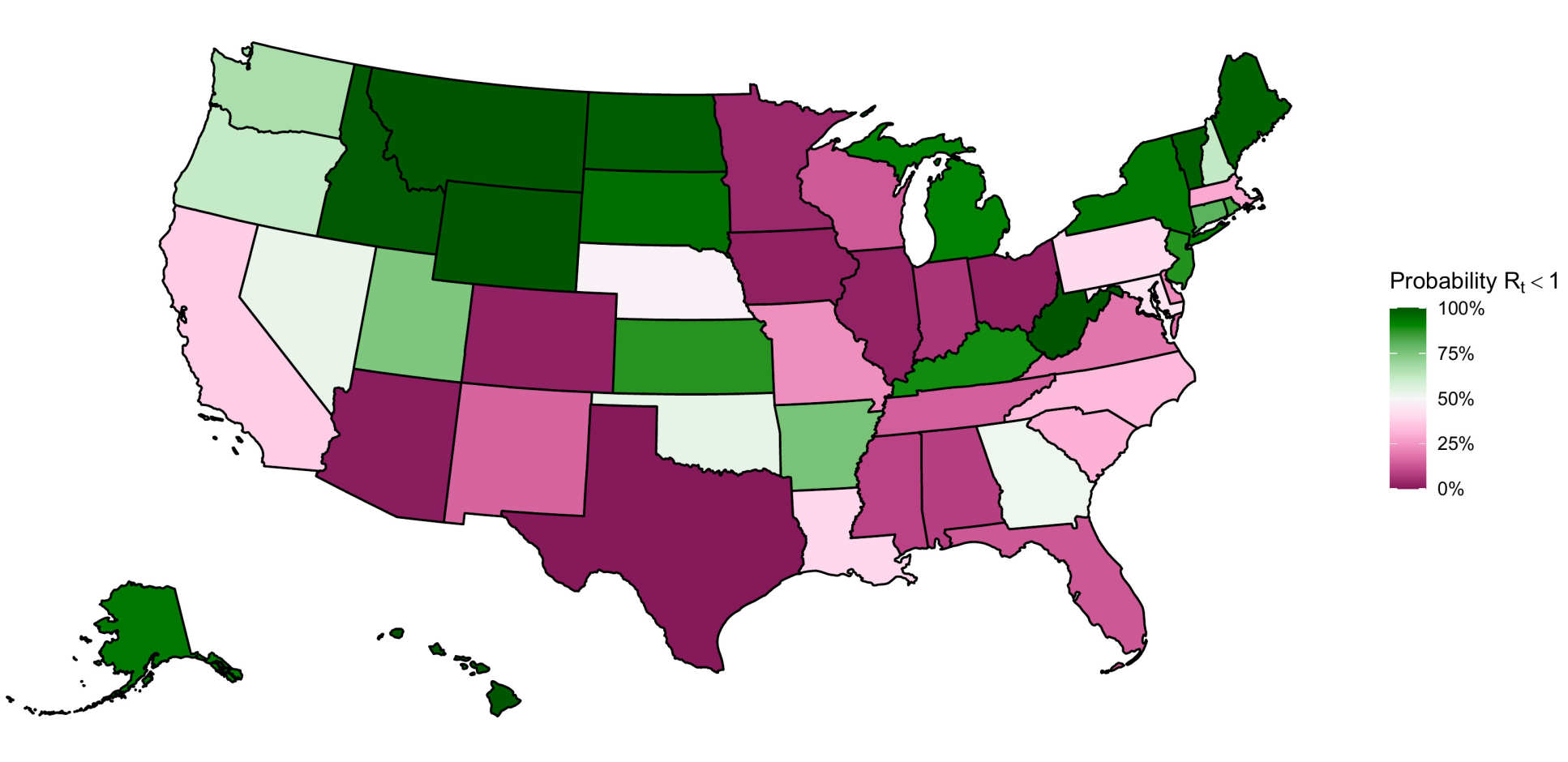Potential US COVID-19 resurgence modelled as lockdowns ease

The coronavirus pandemic is not yet under control in the United States
Increased mobility in the United States as lockdown measures lift could result in a surge of coronavirus infections and deaths.
** UPDATE (03-12-2020): This research (Report 23) has now been peer reviewed and published in Nature communications. **
While the US had an initial 2.2 national average R reproduction number earlier in the outbreak, 24 states still have a reproduction number above the critical threshold of one, Imperial modellers have found.
As states begin to reopen, careful surveillance and monitoring is absolutely essential to avoid a deadly second wave. Dr Samir Bhatt School of Public Health
The findings highlight the need for additional measures to be in place as lockdown restrictions are eased.
The research is published in Report 23 from Imperial College London’s WHO Collaborating Centre for Infectious Disease Modelling within the MRC Centre for Global Infectious Disease Analysis, Jameel Institute (J-IDEA) and Imperial’s Department of Mathematics.
Increased mobility following the relaxation of social distancing rules and norms would result in a substantial resurgence of cases in all states and could lead to a doubling of COVID-19 deaths over the next two months, the researchers find.
In addition to the report, the team have published estimates and visualisations for each US state.

The group found that nationally, 4.1% [3.7%-4.5%] of Americans have been infected with COVID-19, with a wide variation between states: from Montana 0.2% [0.0%-0.4%] to New York’s 16.6% [12.8%-21.6%].
Dr Juliette Unwin said: “Current estimates from our model of the US suggest that the epidemic is unfortunately not yet under control in many states. This suggests that other interventions are necessary if mobility begins to increase in these states as stay-at-home orders are eased.”
Dr Samir Bhatt, who was recently appointed by New York Governor Andrew Cuomo to provide technical advice and analyze metrics throughout the state's reopening process, said: "We show that even as daily deaths decrease nationally, transmission still persists throughout the United States and there is strong evidence that the epidemic is not under control. As states begin to reopen, careful surveillance and monitoring is absolutely essential to avoid a deadly second wave."
As Dr Bhatt was appointed earlier this week, Governor Cuomo said: "The Imperial College model, as we've been following this for weeks, was the best, most accurate model".

The team estimate a US national average initial reproduction number R(t=0) of 2.2 [0.3-5.0], which varied due to differences in population density between states (R(t=0) of 0.3 in Montana, to R(t=0) of 5.0 in New York). Almost half of the states (24) have a mean reproduction number, R(t), above one.
For an outbreak to be under control, the R(t) has to be below one. Only 15.7% of States have 95% credible intervals that are completely below one.
Higher reproduction numbers are geographically clustered in the South and Midwest, while the Imperial infectious disease modellers estimate lower reproduction numbers in states that have already suffered high COVID-19 mortality, as in the Northeast.

These current reproduction numbers suggest that, while all states have substantially reduced their reproduction numbers, the epidemic is not yet under control. Effective additional measures have to be in place when loosening current restrictions.
Simulating higher mobility
Simulations of increased mobility in the absence of other effective infection control measures show that substantial resurgence is expected. In this scenario the deaths expected over a two-month period would exceed current levels by more than two-fold.
The Imperial group's estimates are not projections, the authors emphasise.
Dr Seth Flaxman said: "We calculate how many people in each US state have been infected with COVID-19 and how many people are currently infectious. Our estimates rely on death data, which is the most reliable and consistent source of information on the spread of the epidemic. We incorporate patterns of human movement to inform our epidemiological model, while rigorously quantifying the statistical uncertainty inherent in our estimates."
Dr Swapnil Mishra said: “Our analysis clearly shows that transmission of COVID-19 in the US has decreased both with changes in individual behavior and interventions from state governments. Despite those positive gains, many states are not under control, and those that are, should still take great caution when considering how and when to ease interventions. Increasing surveillance and monitoring capacities will be essential for keeping the epidemic contained.”

Professor Christl Donnelly added: “The USA, like many other countries, is facing a tremendous public health challenge. Our detailed analyses have documented the progress achieved by many states in transmission control so far, as well as identifying those where transmission has not yet been sufficiently reduced.”
Modelling the US outbreak
The United States currently has the highest recorded COVID-19 mortality of any country.
As of 19 May 2020, the Centers for Disease Control and Prevention reported 90,340 confirmed or probable COVID-19-related deaths which is more than twice the number of deaths reported in the next most severely-impacted country.

In order to control the spread of the epidemic and prevent health care systems from being overwhelmed, US state governments have implemented a number of public health measures (so-called non-pharmaceutical interventions, or NPIs) to reduce the transmission of COVID-19 including “stay-at-home” orders, bans on gatherings, and business and school closures.
The report includes estimates for each state on the number of individuals infected, the reproduction number as an indicator of transmission – the number of people one infected individual will infect – and uses mobility data to measure the impact of NPIs on disease transmission.
Mobility data captures the number of people going out and the time they spend at places during visits to groceries, pharmacies, parks, transit stations, retail, recreation, residential and workplaces.
To describe changes in the number of people going out and their time spend outside (expressed as a percentage increase in mobility), the data is compared with a mobility data collected prior to lock-down measures being implemented (baseline).
The new report examines the impact of relaxing social distancing measures with a 20% and 40% return in mobility. The report does not address the potential effect of additional behavioural changes or interventions, such as increased mask-wearing or testing and tracing strategies. In addition, it assumes the relationship between mobility and transmission remains unchanged.
Since the emergence of the new coronavirus (COVID-19) in December 2019, the Imperial College COVID-19 Response Team has adopted a policy of immediately sharing research findings on the developing pandemic.
Report 23 can be read on the Imperial College COVID-19 Response Team webpages, and the modelling, visualisations and source code can be found on Github.
[Picture credits: US lockdown protestors, Shutterstock; New York street, Anthony Quintano; all other images, Imperial College London]
Article text (excluding photos or graphics) © Imperial College London.
Photos and graphics subject to third party copyright used with permission or © Imperial College London.
Reporter
Andrew Scheuber
Communications Division
Dr Sabine L. van Elsland
School of Public Health